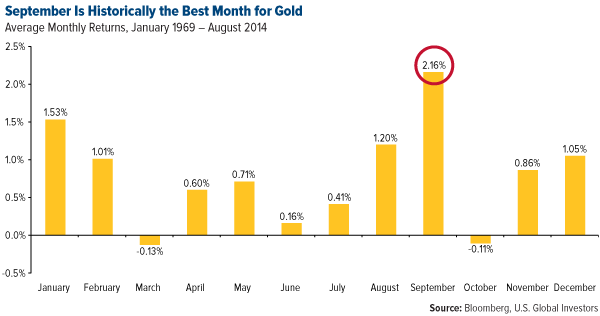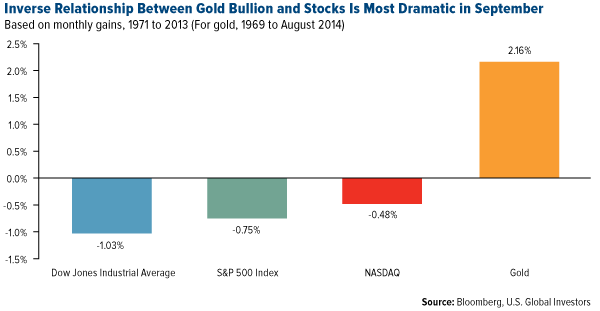In American poet W. S. Merwin’s poem “To the Light of September,” the speaker calls the ninth month “still summer,” yet with a “glint of bronze in the chill mornings.”
I agree—to an extent. Here in San Antonio, Texas, home of U.S. Global Investors, we’re most definitely still in the summer season. But in the investing world, when we talk about September, there’s a glint not of bronze but another precious metal: Gold.
That’s because September is historically gold’s best-performing month of the year, returning 2.16 percent on average since 1969. 
I invite you to compare the chart above, updated to reflect the most recent monthly returns, to the one published this time last year. 
Drivers of Gold
There are several seasonal factors that explain why gold glitters a little more brightly in September. The most notable reason is what I call the Love Trade. In India, this month marks some of the most spirited gold-buying in anticipation of Diwali, which falls on October 23 this year. Following closely behind is the Indian wedding season, when gold is purchased for the bridal trousseau and as gifts in jewelry form. And September is normally when retailers restock their wares ahead of Christmas and after the Islamic month of Ramadan, at the end of which gold jewelry is commonly exchanged.
Another explanation might also be the inverse relationship between bullion and stocks, which only becomes more apparent in September. Earlier this week I discussed how September is historically the worst month of the year to trade stocks in. It’s very possible that many investors turn to gold in September, knowing that the month’s stock returns are typically poor. 
The yellow metal had a tough 2013—its worst since 1981, in fact—and in September its price fell 5 percent, from $1,396 an ounce to $1,327. Although a movement such as this is generally normal for gold, a loss in the ninth month is somewhat rare. In the last 20 years, there have been only five Septembers in which gold prices ended lower than they started at: 1996, 2000, 2006, 2011 and 2013. That’s once every three and a half years on average.
We’re only a few days into the month, and so far spot prices have dropped about 1.6 percent. But this is completely in line with gold’s normal behavior. As I pointed out in the second part of “Managing Expectations,” it has a daily standard deviation of ±1 percent.
Disclosure and Disclaimer: Please consider carefully a fund’s investment objectives, risks, charges and expenses. For this and other important information, obtain a fund prospectus by visiting www.usfunds.com or by calling 1-800-US-FUNDS (1-800-873-8637). Read it carefully before investing. Distributed by U.S. Global Brokerage, Inc. *Morningstar Overall Rating™ among 71 Equity Precious Metals funds as of 6/30/2014 based on risk-adjusted return.
Past performance does not guarantee future results.
All opinions expressed and data provided are subject to change without notice. Some of these opinions may not be appropriate to every investor.
Gold, precious metals, and precious minerals funds may be susceptible to adverse economic, political or regulatory developments due to concentrating in a single theme. The prices of gold, precious metals, and precious minerals are subject to substantial price fluctuations over short periods of time and may be affected by unpredicted international monetary and political policies. We suggest investing no more than 5% to 10% of your portfolio in these sectors.
Morningstar Ratings are based on risk-adjusted return. The Morningstar Rating for a fund is derived from a weighted-average of the performance figures associated with its three-, five- and ten-year (if applicable) Morningstar Rating metrics. Past performance does not guarantee future results. For each fund with at least a three-year history, Morningstar calculates a Morningstar Ratingä based on a Morningstar Risk-Adjusted Return measure that accounts for variation in a fund’s monthly performance (including the effects of sales charges, loads, and redemption fees), placing more emphasis on downward variations and rewarding consistent performance. The top 10% of funds in each category receive 5 stars, the next 22.5% receive 4 stars, the next 35% receive 3 stars, the next 22.5% receive 2 stars and the bottom 10% receive 1 star. (Each share class is counted as a fraction of one fund within this scale and rated separately, which may cause slight variations in the distribution percentages.)
The Dow Jones Industrial Average is a price-weighted average of 30 blue chip stocks that are generally leaders in their industry. The S&P 500 Stock Index is a widely recognized capitalization-weighted index of 500 common stock prices in U.S. companies. The Nasdaq Composite Index is a capitalization-weighted index of all Nasdaq National Market and SmallCap stocks.
Standard deviation is a measure of the dispersion of a set of data from its mean. The more spread apart the data, the higher the deviation. Standard deviation is also known as historical volatility.
